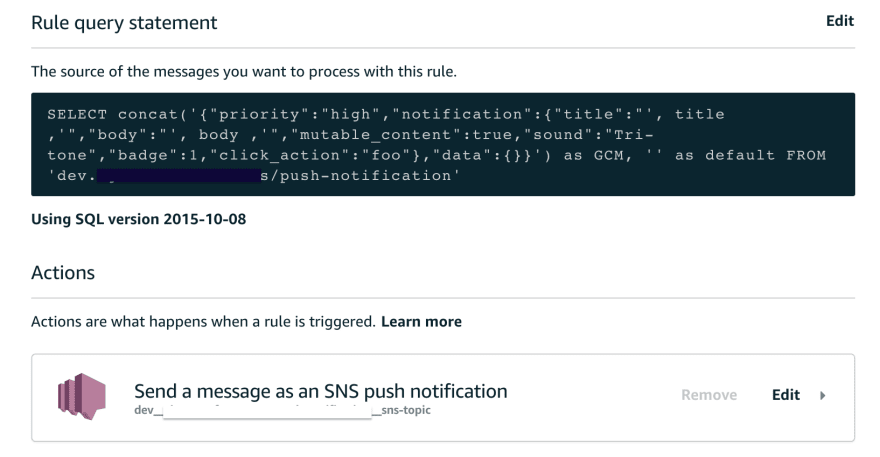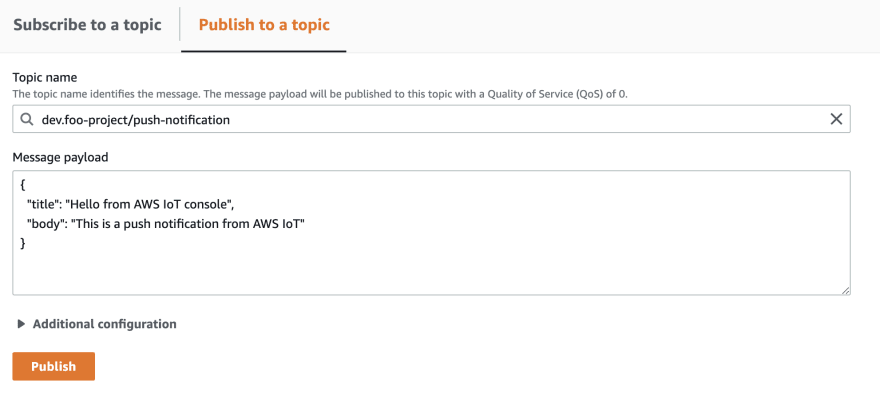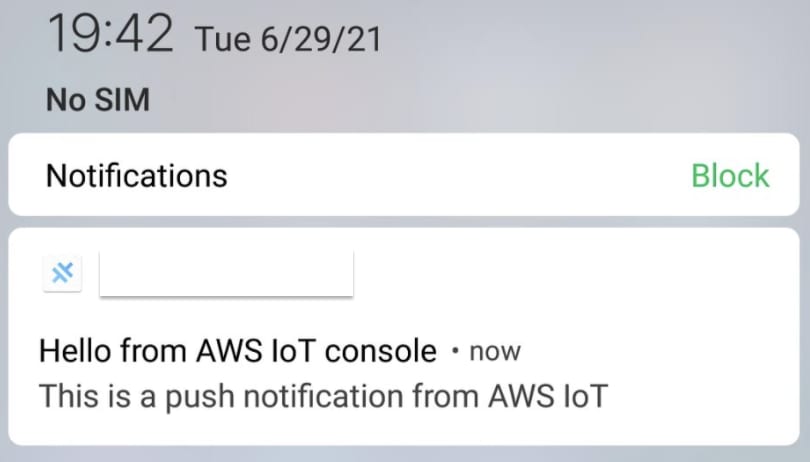51
Serverless Push Notification With AWS IoT
AWS IoT is an option to create IoT devices without back-end servers as it provides MQTT as a service for us. Having a mobile application to interact with the devices is also possible without servers thanks to AWS Cognito that enables us to access many AWS services securely from the mobile application.
With this setup, serverless push notification from IoT devices to the mobile application can be achieved with only a few more configuration. And since I rarely find any example on this topic so I put it here for anyone exploring the option.
Use IoT Rule SQL like this to transform the data published into a topic to a valid GCM/FCM payload and forward it to Platform Application Endpoints.

This post focuses only on how to set up the push notification with AWS IoT. Readers are assumed to be familiar with following topics.


1. Aquire FCM ServerKey from Firebase Console and use it to create SNS Platform Application.
aws sns create-platform-application \
--name dev.foo-project.foo-mobile-devices.sns-app \
--platform GCM \
--attributes PlatformCredential=<Your FCM ServerKey>2. Create the SNS Topic.
aws sns create-topic --name dev__foo-project__push-notification__sns-topic3. The IoT rule we are about to create will need an IAM role that grants a permission to trigger the above SNS Topic.
echo '{
"Version": "2012-10-17",
"Statement": [
{
"Effect": "Allow",
"Principal": {
"Service": "iot.amazonaws.com"
},
"Action": [
"sts:AssumeRole"
]
}
]
}' > trust-policy.json
echo '{
"Version": "2012-10-17",
"Statement": [
{
"Effect": "Allow",
"Action": "sns:Publish",
"Resource": "arn:aws:sns:<your_region>:<your_account_id>:dev__foo-project__push-notification__sns-topic"
}
]
}' > policy.json
aws iam create-role --role-name dev.foo-project.iot-rule-action.role --assume-role-policy-document file://trust-policy.json
aws iam put-role-policy --role-name dev.foo-project.iot-rule-action.role --policy-name dev.foo-project.iot-rule-action.policy --policy-document file://policy.json4. And finally, the main piece of today recipe, the IoT Rule.
echo '{
"Sql": "SELECT concat('{\"priority\":\"high\",\"notification\":{\"title\":\"', title ,'\",\"body\":\"', body ,'\",\"mutable_content\":true,\"sound\":\"Tri-tone\",\"badge\":1,\"click_action\":\"foo\"},\"data\":{}}') as GCM, '' as default FROM 'dev.foo-project/push-notification'",
"Actions": [
{
"Sns": {
"MessageFormat": "JSON",
"TargetArn": "arn:aws:sns:<your_region>:<your_account_id>:dev__foo-project__push-notification__sns-topic",
"RoleArn": "arn:aws:iam::<your_account_id>:role/dev.foo-project.iot-rule-action.role"
}
}
]
}' > rule-payload.json
aws iot create-topic-rule \
--rule-name dev__foo_project__push_notification__iot_rule \
--topic-rule-payload file://rule-payload.jsonIt can transform a payload of the form
{ "title": "...", "body": "..." } to a valid FCM/GCM payload.
1. The mobile application is set up to use AWS Cognito + Amplify Authentication. Here is an example as a React Component.
import Amplify, { Auth } from "aws-amplify";
import { Authenticator, SignIn } from "aws-amplify-react";
Amplify.configure({
aws_project_region: 'your_region',
aws_cognito_identity_pool_id: 'your_cognito_identity_pool_id',
aws_cognito_region: 'your_region',
aws_user_pools_id: 'your_user_pool_id',
aws_user_pools_web_client_id: 'your_user_pool_client_id',
aws_appsync_authenticationType: "AMAZON_COGNITO_USER_POOLS",
oauth: {},
});
Auth.configure({
authenticationFlowType: "USER_PASSWORD_AUTH",
});
Amplify.Logger.LOG_LEVEL = "VERBOSE";
const AppWithAuth: React.FC = () => {
const [isSignedIn, setSignedIn] = useState(false);
return (
<Authenticator
onStateChange={(state) => {
if (state === "signedIn") {
setSignedIn(true);
}
}}>
<SignIn />
<App ready={isSignedIn} />
</Authenticator>
)
}2. After the user signin, we can use the credentials from Cognito to create any AWS SDK Clients
import { SNSClient } from "@aws-sdk/client-sns";
import { IoTClient } from "@aws-sdk/client-iot";
const amplifyCredentialProvider = async () => {
const awsCredentials = await Auth.currentCredentials();
return Auth.essentialCredentials(awsCredentials);
};
export const iotClient = new IoTClient({
region: config.region,
credentials: amplifyCredentialProvider,
});
export const snsClient = new SNSClient({
region: config.region,
credentials: amplifyCredentialProvider,
});3. The application retrieves FCM token from Firebase and use SNSClient to create the platform application endpoint and subscribe to the SNS topic
import { ActionPerformed, PushNotifications, PushNotificationSchema, Token } from "@capacitor/push-notifications";
import { CreatePlatformEndpointCommand, SubscribeCommand } from "@aws-sdk/client-sns";
const App: Rect.FC<{ready: boolean}> = ({ ready }) => {
useEffect(() => {
if (ready) {
// Retrieve FCM Token
PushNotifications.addListener("registration", async (token: Token) => {
const endpoint = await snsClient.send(
new CreatePlatformEndpointCommand({
PlatformApplicationArn: config.snsPlatformApplicationArn,
Token: token.value,
})
);
const subscriptionResult = await snsClient.send(
new SubscribeCommand({
Protocol: "application",
TopicArn: config.snsTopicArn,
Endpoint: endpoint.EndpointArn,
})
);
});
// FCM Registration Error
PushNotifications.addListener("registrationError", (error: any) => {
});
// Notification received when the app is in foreground
PushNotifications.addListener("pushNotificationReceived", (notification: PushNotificationSchema) => {
});
// Notification data when the user tab the notification in system tray
PushNotifications.addListener("pushNotificationActionPerformed", (notification: ActionPerformed) => {
});
PushNotifications.register();
}
}, [ready])
return (
<BlaBlaBla />
)
}1. We will use AWS Console' MQTT Test Client tool to simulate a device publishing to the MQTT topic.

2. Yey!, the notification arrives at my phone.

51
